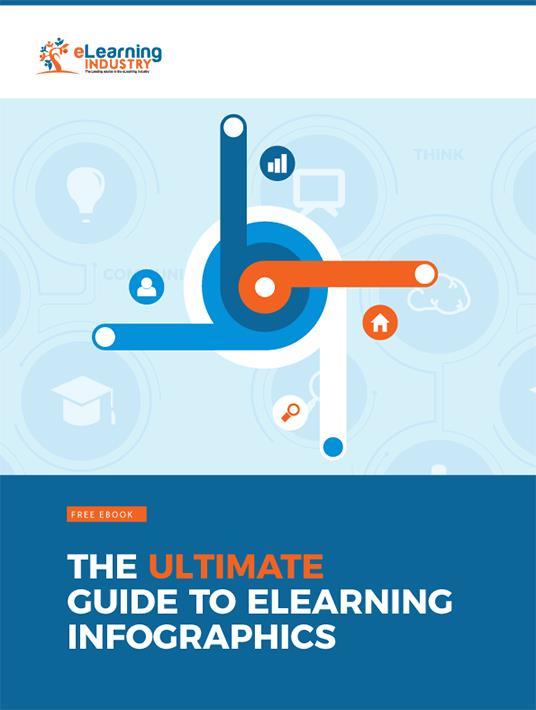Why You Should Include eLearning Infographics In Your eLearning Course Design
eLearning courses help busy, distracted, and overwhelmed online learners get the information they need anytime, anywhere. Therefore, it is crucial to design eLearning courses that are compelling and to the point. eLearning infographics are a great way of achieving that. These visually engaging online training tools offer a snapshot of notable trends, stats and takeaways. They not only add color to your eLearning course but they also ensure that you are able to convey essential knowledge. When it comes to statistics, people prefer to look at charts and figures instead of indulging in heaps of data difficult to decipher. Here are the top 7 reasons why you should go for eLearning infographics when designing an eLearning course.

1. Simplify Abstract Concepts
Among the many significant benefits of using eLearning infographics, representation of statistics tops the list. Research shows that when dealing with numbers, eLearning infographics can help to improve knowledge assimilation. Instead of putting your online learners through a great deal of mental gymnastics, you can use eLearning infographics to depict complex data. This can be done by creating charts or trends which lead to conclusive results instead of creating confusion. More involved concepts that have many branches of sub-topics can be displayed in a single eLearning infographic. This breaks down the information into easily digestible pieces, thus making it easier for online learners to connect the dots.
2. Improve Memory Retention
eLearning courses may often require online learners to go through large amounts of data that are more difficult to process. Memorizing it is a total different ballgame. The chances of retaining data are much higher when using eLearning infographics instead of simply relying on text. It is much easier for the human mind to retain knowledge when it appears in the form of charts, images or other visual elements. eLearning infographics require less effort and time. As such, online learners are more likely to retain the key stats and facts. Furthermore, the clear and concise presentation of data helps online learners evaluate and analyze the information.
3. Minimize eLearning Course Clutter
One of the most overlooked benefits of using eLearning infographics is the ability to streamline your eLearning course design. For example, instead of adding text blocks and lengthy bullet lists, an eLearning infographic covers a comprehensive overview of the main points. Online learners can simply review the graphic in order to gather the key information. You can also compile all relevant images and charts in one centralized location rather than dispersing them throughout the eLearning course layout and filling every inch of white space. This also helps to reduce cognitive overload and improves eLearning content comprehension, as online learners are able to evaluate the entire picture at once instead of just examining bits and pieces of the puzzle. For example, they can view relevant images, graphs, and stats that support the key facts.
4. Increase Learner Engagement
It is unlikely that coursework is high on the priority list for online learners. Everybody has their plate full nowadays. No one wants to waste their time on an eLearning course that doesn’t make a meaningful connection or offer real-world value. You can turn the tables around by using eye-catching eLearning infographics. If you are able to engage your online learners, they are more likely to stick with the eLearning course instead of clicking away. eLearning infographics can act as a food for thought for online learners. For example, they review the graphic and then engage in lively online discussions with their peers.
5. Bridge Performance And Skill Gaps
You can use eLearning infographics as a step-by-step guide for your corporate learners to bridge gaps. For instance, explore each step of a work-related task, then highlight common areas for improvement, such as skills that many employees may need to fine-tune in order to improve productivity. To accomplish this, you must first identify individual gaps and then pinpoint patterns. For instance, LMS metrics reveal that corporate learners have trouble with interpersonal skills. They are performing poorly on online training simulations and branching scenarios that involve group dynamics or one-on-one communication. In response, you can create an eLearning infographic that centers on these skill sets.
6. Help Online Learners Connect The Dots
Comparative studies can often lead many into confusion, especially when you have large amount of data to disperse. eLearning infographics are a great way of correlating ideas and connecting related concepts. It can be difficult to see the correlation between sub-topics if you rely on text-based descriptions. Consequently, a lot of online learners will lose interest and simply give up, as comprehension involves too much time and effort. With eLearning infographics, you have the ability to contrast and compare similar topics or ideas.
7. Reduce Online Training Seat Time
Online learners assimilate information more rapidly when it’s in visual format. Thus, eLearning infographics reduce online training seat time and improve eLearning ROI. Less online training seat time equals more time on the job. Employees get all the information they require so that they can quickly apply what they’ve learned and improve their proficiency. This is one of the primary reasons why you need to create topic-centered eLearning infographics, instead of trying to cover too much ground. Corporate learners must be able to focus on a single learning objective or task before moving onto the next. These valuable online training tools allow them to explore the subject matter in depth so that they can fully understand the real-world applications, such as how they will apply what they’ve learned when they venture onto the sales floor.
eLearning infographics are powerful online training tools that transfer valuable information in an effective and engaging way. You can tailor the data to meet the needs of your online learners without running the risk of making the eLearning course confusing or boring. Remember, all this can only be achieved if, and only if, you provide high-quality eLearning content. You need to be clear about the message you want to convey. Otherwise, online learners are likely to click away before they absorb the subject matter.
Do you want to create amazing eLearning infographics for your eLearning course? Download our Free eBook: The Ultimate Guide To eLearning Infographics to discover how to work with eLearning Infographic templates, the benefits of including eLearning Infographics into your eLearning course design, the steps you should follow to create them, as well as examples of creative uses and must-have features that exceptional eLearning Infographics typically include.






